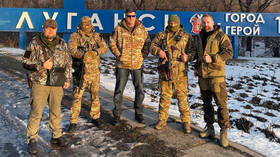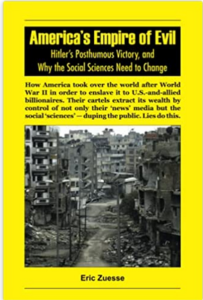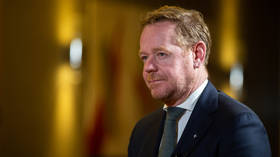 Konstantin Kisin emigrated to Britain in 1993 at age 11, to join the flood of Russian emigres, high and low, looking for a new life. Kisin is the usual: loves the West, hates the Soviet Union, hates Putin. Ironically, the best writing in this billet doux is Kisin’s depiction of the Soviet Union as genuinely socialist: health care, free education, economic equality. His paean to the freedom and dignity that many in the West take for granted, as reviewed by Peter Boghossian, is self parody. Kisin is also a stand-up comic, a would-be enfant terrible, so he’s comfortable with over-the-top. We learn from the book blurb that ‘he experienced both untold wealth and grinding poverty.’ Not.
Konstantin Kisin emigrated to Britain in 1993 at age 11, to join the flood of Russian emigres, high and low, looking for a new life. Kisin is the usual: loves the West, hates the Soviet Union, hates Putin. Ironically, the best writing in this billet doux is Kisin’s depiction of the Soviet Union as genuinely socialist: health care, free education, economic equality. His paean to the freedom and dignity that many in the West take for granted, as reviewed by Peter Boghossian, is self parody. Kisin is also a stand-up comic, a would-be enfant terrible, so he’s comfortable with over-the-top. We learn from the book blurb that ‘he experienced both untold wealth and grinding poverty.’ Not.
There are two more slots for Konstantin. Jewish. Probably 1/4. His grandfather was a gynaecologist who in 1980 protested openly the Russian invasion of Afghanistan, promptly became a nonperson, and his family blacklisted. The fall from Soviet grace was hard (sorry, no ‘grinding poverty’) and grandpa emigrated to Britain.
The real story on grandpa is most likely the following. His Jewish great-grandpa was falsely arrested in the 1920s. However, as an engineer, he was still of use to the new socialism, so he lived out his 10 years in the Gulag with three more years added for the hell of it and exile in Siberia till Khrushchev spilled the beans on Stalin and sent everyone home. He had been a devoted communist at the start and seems to have left his prison years behind, welcomed back into the socialist fold, allowing his son (Konstantin’s father) to become the celebrated doctor with fancy car and prestige apartment. Thank you, Nikita.
The family quickly became part of the nomenklatura and things looked rosy until 1980. Clearly, the gynaecologist had become a dissident, foolishly poking his finger at the bear at a very delicate time. Being a dissident Jew in 1980 in Russia, with Israel and world Jewry hysterically shouting down naive Soviet calls for peace and socialism, demanding the mass emigration of half the Soviet elite NOW, was not a happy vocation. Unless you planned to leave. Again the story is muddled, but Konstantin’s story is that his parents decided he should join grandfather in England and go to a private school. Many Russians gave up hope in the 1990s and looked to the West for a good future. So at 11, he was put on a plane unaccompanied, and began his long march to fame and fortune at the heart of Russia’s traditional enemy.
His other moniker is dissident. While Konstantin never suffered directly in Moscow and became a devoted anglophile, he seems to have inherited the smart-ass, rabblerouser Jewish gene, and he prides himself in his tussles with political correctness [critical race theory (CRT)], occasionally being banned and censored, which of course only adds to his cachet, provides grist for his podcast and more ‘untold wealth’.
That is how I stumbled upon Kisin. What a puzzle: Jewish Russian emigre, smart, young, anglophile … but ‘alt-right’, as he gleefully admits he’s been called? ‘All very, very Soviet.’ Disser of CRT, trans, lgbtqaetc. And bestselling author at 40. I wanted to piece together this puzzle.
An Immigrant’s Love Letter to the West starts with an earnest quote from Solzhenitsyn about the decline of the spiritual life leading to social collapse: a tree with a rotten core cannot stand. Hmm. Kisin as a footnote to Solzhenitsyn’s Jeremiad about the decline of both the Soviet Union and the West, but no. Kisin was referring only to the Soviet Union, still hoping the West will recover its soul. It is more interesting as a picture of the confused attempt to justify abandoning his homeland and embrace its enemy. You feel sorry for him at the end, with no sense of where he belongs.
He starts with the anecdote about opening Tamerlane’s tomb on June 21, 1941, inscribed Whoever disturbs my tomb will unleash an invader more terrible than I. Tamerlane was given a proper Muslim burial on December 20, 1942, in time for the Battle of Stalingrad, ensuring the defeat of Hitler, so that had a happy ending. He sees CRT as the equivalent of Tamerlane. ‘Today, the fate of western civilization hangs in the balance once again. The tomb of discord and division has been forced open by a small group of ideological zealots. Retreat is no longer an option.’
True, the world around us is indeed changing at unprecedented speed. People are indeed afraid to express their viewers, men and women are opponents, mention of race separates us. He’s right about CRT, but wrong about just about everything else.
Trust me: West is best
His first two chapter are great but for the wrong reasons. The social legacy of the Soviet Union which morphs into black Americans’ ‘the talk’, advice to children about how to act if they’re stopped by police. He had the same lecture as a child in the Soviet Union (SU), except he was instructed ‘how to keep our private conversations secret from the State.’ Cool. The US is becoming like the SU. He trots out Pavlik Morozov (a Stalin-era story of a boy betraying his ‘wrecker’ father), comparing him to Bernie Sanders (?) as a ‘useful idiot’. ‘They are generally the sort of college-educated westerner who embraces this bankrupt ideology [communism] without having any understanding of its real-world implications.’
He then boldly admits that there was optimal income distribution in the Soviet Union (the elite earned 4x what workers earned) vs the 1000+x difference in the West). This was in fact the secret as to why the SU survived so long (and the reason it is mourned by the vast majority of Russians today). Free health, university education (students actually paid a stipend to study!), no racism, no ‘white privilege’, women’s rights, abortion, child care … Things he is disappointed not to see in the West, which he can’t understand. But there’s a catch in all this. Equality, but where everyone is poor, i.e., the Soviet solution to inequality is to cut off people’s legs, though he doesn’t specify that it’s the rich people’s legs that are cut off, so to speak.
Okay, the SU never managed to ‘catch up’ to the West in money income, consumerism, but that’s not the point. At the Muslim Association of Canada 2024 conference ‘Seizing the moment’, Hussein Elkazzaz addressed this false comparison of the West with the Islamic world, which is really just the other ‘other’ for us in the West, like communism.
It assumes you are western, interested only in money and things, so if, say, Egypt is poor, then it is bad, a failure. But, Elkazzaz asks, can you worship freely? Observer the holy days in a vibrant spiritual community? Bring your children up in a safe environment, without the Hollywood-driven culture undermining morality? Some Muslim Canadians go back when they start a family, as that is what’s really important to them, not money and fancier things.
For communism too, money and commodities were not considered as important as good education, health, holidays, camps for children, culture that was moral. Muslims, more than communists, are caught between the two worlds, spiritual growth or economic growth. And they are never really compatible. The SU was operating under the handicap of state-legislated atheism, officially replacing religion with communist ideology, a bad fit as it turned out, as ideological as capitalist America or Muslim Egypt but without the latter’s spirituality.
A study of East Germany and Bulgaria revealed that women had twice as many orgasms in the socialist bloc than in the West. The men were better husbands, the women weren’t stressed by money worries, everyone was equally ‘poor’. Which is nonsense as people didn’t starve. They lived comfortably. The Soviet Union was widely respected in the global south. That’s why I liked communism. It was people-oriented, a friend of the postcolonial world, not $-oriented (to a fault). I liked that workers were honored vs our capitalists feted and treated like kings.
Re universal health care, Kisin is blissfully unaware, by his own admission, as to why Trump, ‘even the almighty Clintons and Barack Obama, couldn’t figure that one out.’ Really? How about capitalism? But no, Kisin loves capitalism. And let’s not forget sunny Cuba and its woes. Sanctions and subversion for 60+ years. The SU endured the same treatment from 1917 till it finally collapsed 74 years later, bringing down most of the socialist world with all its many advantages.
As for freedom, again Kisin admits his parents, and anyone else who cared, had lively debates at home. Everyone was literate and all the pre-Soviet-era classics of world literature and science were available to all. Yes, you had to watch your tongue in public. The SU was never really at peace with a hostile West, so it was naturally paranoid. If you paid any attention to world affairs, that would have been abundantly clear. Nice Cuba also has to restrain its frustrated population to preserve socialism.
Socialism is not easy to build and is easily destroyed, as the whirlwind collapse of the SU showed. And what comes after it is the nasty what-came-before, only worse, as vengeance must be enacted. So empty shelves are a drag, but as long as no one suffers malnutrition, there is definitely a good case to keep socialism alive in the face of unremitting hostility.
Magical sky men
Kisin identifies the underlying problem being the Russian revolution itself, inspired by ideology rejecting real world capitalism. ‘Instead of wasting time trying to create a perfection, which can’t be achieved, the best we can do is deal with reality as we find it.’ Presumably that goes for all revolutions. Kisin excepts the American revolution and its ideology of liberalism, free speech and consumerism.
Kisin compares the modern West to the cargo cults that sprung up among the Melanesian islanders during and after WWII. The trinkets, guns, SPAM were all magical things these nice sky men brought. The Melanesians are skilled carvers so they fashioned mock guns and headphones of wood and sat in makeshift control towers, even flapping their arms on pretend runways. Lesson? ‘We have forgotten that the prosperity, safety, life expectancy, stability and freedoms we enjoy did not just fall out of the sky. They have stood the test of time.’ Oh, really?
His analogy with Melanesians is flawed. They saw the sky men as gods with nice miraculous things, and they wanted the things. They didn’t care about western ideology, which indeed is flimsy and is collapsing before our eyes, much like the Soviet ideology of ‘real existing socialism’ collapsed before his eyes. And the magical things we get from Chinese sky men are ‘here today, gone tomorrow’, leaving us high and dry, much like the Melanesians.
As he described the Melanesians, I was thinking ‘what an apt analogy for the mindless consumerism of the late Soviet period, when anything western, from bubble gum to sleek cars, was worshipped and coveted as if it could magically make Soviets feel happy.
Kisin and his fellow Russians view westerners as naive and ‘drunk on decadence, so accustomed to liberty and prosperity that they take it for granted and appear to be throwing it away, completely unaware of its inherent value and fragility.’ They are replacing it with postmodern ideologies culminating in transgenderism, and the cancelling/ destruction of western culture as racist etc.
Kisin is a mirror image to Dmitry Orlov, a hard-nosed Russian American whose Reinventing Collapse: The Soviet Experience and American Prospects (2011) compare the collapse-preparedness of the US and the SU, arguing that the SU was a mild collapse compared to what’s in store for a totally unprepared, over-the-top arrogant US. Like Orlov, Kisin sees the weakness underlying western society, but can’t see the bankruptcy of both the ideology and reality of the West. His hopes for a miraculous renewal of western society are doomed, much like Gorbachev’s hopes of renewing ‘real existing socialism’ with hasty market reforms, still trapped in the materialist ideology.
I can sympathize with Kisin’s naivete, as I became a communist and lived in hope of a Soviet renewal, reaffirming the ideology of universal brotherhood, real equality, state-funded health and education. It turned out that that ideology-reality was doomed too. Too far apart there. They are equally far apart in the West now too. How about a reality check? Prosperity? Safety? Life expectancy? Stability? Freedoms? Peace? No comment.

Apologist Kisin and Polyanna Pinker
Kisin is an acolyte of Steven Pinker, whose Enlightenment Now: The Case for Reason, Science, Humanism, and Progress (2018) seriously claims the world has never been in such a wonderful state, prosperous, blessed with ‘knowledge, mobilized to improve human welfare’.
Kisin is a hard-nosed Russian Brit, with no use for ‘pathological altruism’ or any of the ‘wacky, postmodernist, semi-Soviet viruses’. He chastises the West for too much freedom, e.g., Jimi Hendrix or Michael Jackson, ‘as if their success was their undoing.’ Well, yes, they did have too much material success. Soviet artists lived the high life but a very modest one. I don’t know of any tragedies of the scale of Michael Jackson there.
When capitalism takes control of culture, it encourages the image of freedom, while poisoning the actual lives being lived. We need constraints, especially artists, something to fight against in the interests of Truth. If there is no truth, only ‘drugs, sex and rock ‘n roll’, of course, overnight success becomes the road to infamy, culture degenerates. Kisin sneers at lefty ‘massive wasters snorting failed theories and downing shots of communism, or occasionally injecting socialism straight into our veins, even though we know it’s bad for us.’ That’s just the price of ‘freedom’.
Poe, Freud and Visigoths
Edgar Allan Poe explains in The imp of the perverse (1845) that knowing something is bad for us is the one unconquerable force that compels us to do it. Freud took this to Einstein when he asked Freud if we could avoid war and conflict. Freud replied that we have a tendency to self-sabotage, Thanatos. People are their own worst enemies and strive to bring themselves and the world to ruin, ‘to reduce life to its original condition of inanimate matter.’ We distract ourselves from stress, guilt, fear of death with reckless behavior, leading ourselves and the world to destruction.
Kisin can’t explain this (like his incomprehension of the lack of universal health care in the US) except as ‘too much freedom’. That’s no explanation, though again, he is right that we are gaslit into thinking that it’s western culture that’s to blame and that the way forward is backwards, to cancel culture, to yet another revolution. To start again, this time basing our (magical) thinking on race, making sure that there’s a balance of colors everywhere, that this balance, like Lenin’s communism, will somehow bring peace and prosperity. He likens the new ideology to a bacterial infection, which targeted and killed Christianity, the English language and capitalism.
Nonsense! Christianity was in steep decline by the mid-19th century, capitalism is alive and well. Kisin is right about how language is being held hostage (be careful what you say doesn’t hurt anyone’s feelings), but it’s not just woke culture that’s responsible. It’s technology, pushing us to write like AI. You are now a ‘client’ at the public library rather than a patron.
But a good chunk of cancel culture is well-founded. There’s no getting around it: West was in fact built on slavery, racism, militarism and genocide. Kisin has no time for that. But he has no idea how to stop cancel culture and renew the social fabric. Many argue that ‘a good war’ is the solution’ though he demurs. He wants ‘liberals to have a little bit of grit in their oyster.’
Kisin is caught in his ‘love letter to the West’ by the contradictions of capitalism, where freedom means more sexual violence, and social malaise is solved by war, which conveniently increases profit and leads to greater ‘prosperity’. He bemoans the ‘new tsars’ who want to flatten everything and start again, much like what happened in the Soviet Union and which led to woeful results. He compares the West to the Roman empire brought to its knees when Rome was sacked by the Visigoths in the 5th century, quoting Carinal Robert Sarah: Europe has lost the sense of its origins. And, like a tree without roots, it will die. ‘Ancient Greece and Rome were the most advanced civilizations of their day. Technologically, culturally, philosophcally, scientifically and politically. Right up until the moment they collapsed.’ Hello Dmitry Orlov!
From Marx to Islam?
This is what was missing in Marx’s critique of capitalism – the psychological side of any attempt to make socialism work. Contrary to Kisin (and Thatcher), socialism is the only way out of our physical destruction of the world at this point, so we better get on board fast. This (huge) hole in Marx’s social theory was seized upon by CRT, a pseudo-Marxism which views everything via race.
No! Kisin reacts viscerally to CRT, but his hatred of all things Soviet prevents him from appreciating that precious part of Soviet reality: an end to racism, and to make sure, you tax the rich and keep income distribution within bounds. Racism is, in the last analysis, economic. Kisin talks about ‘learning from mistakes’ but has no interest in a fair assessment of Soviet experience as important for us precisely now.
We have to build on what worked in the SU and what didn’t, including psychology as a vital part of any answer. He stands by ‘the marriage of free-market capitalism and western liberal democracy, despite the ‘fact’ that they are both at the center of the problem. He knows that income inequality means a bad society, that ‘people’s subjective experience of life is that they are losing,’ that taxing the rich is the unpalatable answer, i.e., socialism. ‘That the ugliness of socialism is only matched by the grotesqueness of capitalism’s excesses,’ but rather than promoting a political backbone to tax the rich, he lamely concludes that ‘society is usually fucked.’
Kisin considers us ‘by far and away the luckiest people in history.’ He even claims capitalism creates peace (‘The UK is currently a nation at peace.’), meaning Friedman’s Golden Arches theory of conflict prevention. So why are Macdonalds trashed and forced to shut down across the Middle East, as IDF soldiers are fed free Big Macs in pursuit of … by far and away not ‘peace’?
Kisin’s family’s ‘dissident Jew’ status was unpleasant, but understandable. Those that wanted to managed to leave, happy and healthy. The SU was not ‘a complete fucking nightmare’ as Kisin claims. It did not ‘collapse under the weight of its own flaws’ so much as it was subverted to death, done in by paranoia and consumerism. And the post-Soviet ethnic strife was not a return to primordial animal instincts so much as the lifting of a firm social norm of equality, replaced by greed, which loves dissent and strife, the better to chain the masses to a soulless consumerism.
Read some Marx, Kostya! Have another look at your Soviet-Russian homeland which tirelessly fought for peace from 1917 and was met by war, invasion and subterfuge right up until 2024 and for many more horrible, blood-drenched years, until ‘the collective West’ is defeated. Who incited and why the current war in Ukraine? Whose missiles are raining down on Russian Crimea, Belgorod, the Kremlin?
Or better yet, have a look at Islam, which meets your socially conservative goals, but unlike capitalism and like socialism, is not so much concerned with flooding the world with consumer junk, but creating a society where your heath and education are free, where social harmony is maintained by redistributing income, where peace is not just hoped for as a by-product of greed, but is the priority of all people, of society, the ummah. Where we have the best conditions to praise God for the bounties we have been blessed with, where we are encouraged to do this with humility. But then there is not a trace of humility in Kisin’s worship of capitalism and ‘his’ talents (as if he produced them), and his new-found exciting consumerist paradise. Our enfant terrible is really just a terrible infant.
ENDNOTE
The post
East or West? West is Best first appeared on
Dissident Voice.
1 In 2020, an open letter to the Linguistic Society of America requesting the removal of Pinker from its list of LSA Fellows and media experts was signed by hundreds of academics. The letter accused Pinker of a ‘pattern of drowning out the voices of people suffering from racist and sexist violence, in particular in the immediate aftermath of violent acts and/or protests against the systems that created them.’
This post was originally published on Dissident Voice.










